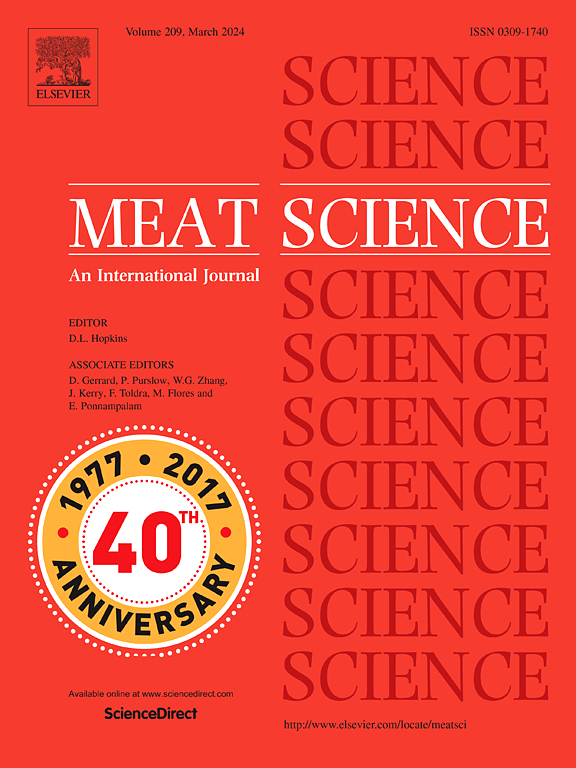Visible-NIR spectroscopic authentication assay for the classification of lamb meat according to pasture-finishing duration
IF 7.1
1区 农林科学
Q1 Agricultural and Biological Sciences
引用次数: 0
Abstract
Spectral analysis of meat combined with chemometric analysis has been identified as a promising tool for authenticating livestock-animal diets. The objectives of this study were (i) to determine whether the visible-NIR spectrum of perirenal adipose tissue (PAT) and caudal adipose tissue (CAT) can reliably discriminate lambs pasture-finished for different durations before slaughter, and (ii) to analyze the kinetics of appearance and stabilization of the visible-NIR spectrum-based pasture signature in PAT and CAT. Four groups of 50–55 lambs were used over three years: lambs finished on lucerne pasture for 0 (L0, concentrate-fed in stall), 21 (L21), 42 (L42) and 63 (L63) days before slaughter. Partial least squares discriminant analysis was applied on PAT or CAT visible-NIR spectra to discriminate the groups. No one adipose tissue reliably discriminated the four groups, with less than 62 % lambs correctly classified. However, visible-NIR spectroscopy was able to discriminate stall-fed (L0) from pasture-finished (L21 + L42 + L63) lambs, with an accuracy of 93.8 % and 87.5 % lambs correctly classified based on PAT and CAT spectra, respectively. The lucerne pasture fingerprint (or signature) on visible-NIR spectrum appeared between 0 and 42 days in more than 95 % of lambs. It stabilized between 42 and 63 days in CAT, but had not stabilized within the range of grazing durations pre-slaughter explored in PAT. Further research into shorter and longer pasture-finishing durations could help determine more precisely the time required for the pasture signature to appear and stabilize in animal tissues.
根据牧场饲养时间对羊肉进行分类的可见-近红外光谱鉴定分析。
肉的光谱分析与化学计量分析相结合,被认为是鉴定家畜日粮的一种有前途的工具。本研究的目的是:(i) 确定肾周脂肪组织(PAT)和尾部脂肪组织(CAT)的可见-近红外光谱是否能可靠地区分屠宰前不同时间段牧草加工的羔羊;(ii) 分析 PAT 和 CAT 中基于可见-近红外光谱的牧草特征的出现和稳定动力学。在三年中使用了四组 50-55 只羔羊:屠宰前在苜蓿草地上完成 0 天(L0,圈养精饲料)、21 天(L21)、42 天(L42)和 63 天(L63)的羔羊。对 PAT 或 CAT 可见光-近红外光谱采用偏最小二乘法判别分析来区分各组。没有一种脂肪组织能可靠地区分四个组别,只有不到 62% 的羔羊能被正确分类。然而,可见-近红外光谱分析能够区分厩肥(L0)羔羊和牧草加工(L21 + L42 + L63)羔羊,根据 PAT 和 CAT 光谱正确分类的准确率分别为 93.8 % 和 87.5 %。可见光-近红外光谱上的苜蓿草指纹(或特征)在 0 至 42 天期间出现在 95% 以上的羔羊身上。在 CAT 中,苜蓿草指纹在 42 到 63 天之间趋于稳定,但在 PAT 中,苜蓿草指纹在屠宰前的放牧时间范围内并未趋于稳定。进一步研究更短和更长的牧草结束持续时间有助于更准确地确定牧草特征在动物组织中出现和稳定所需的时间。
本文章由计算机程序翻译,如有差异,请以英文原文为准。
求助全文
约1分钟内获得全文
求助全文
来源期刊

Meat Science
工程技术-食品科技
CiteScore
12.60
自引率
9.90%
发文量
282
审稿时长
60 days
期刊介绍:
The aim of Meat Science is to serve as a suitable platform for the dissemination of interdisciplinary and international knowledge on all factors influencing the properties of meat. While the journal primarily focuses on the flesh of mammals, contributions related to poultry will be considered if they enhance the overall understanding of the relationship between muscle nature and meat quality post mortem. Additionally, papers on large birds (e.g., emus, ostriches) as well as wild-captured mammals and crocodiles will be welcomed.
 求助内容:
求助内容: 应助结果提醒方式:
应助结果提醒方式:


